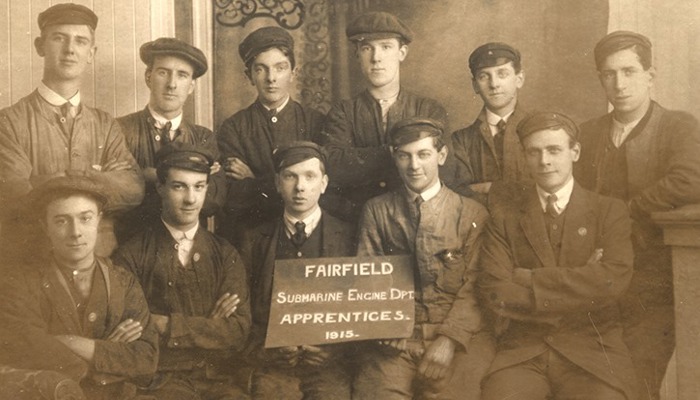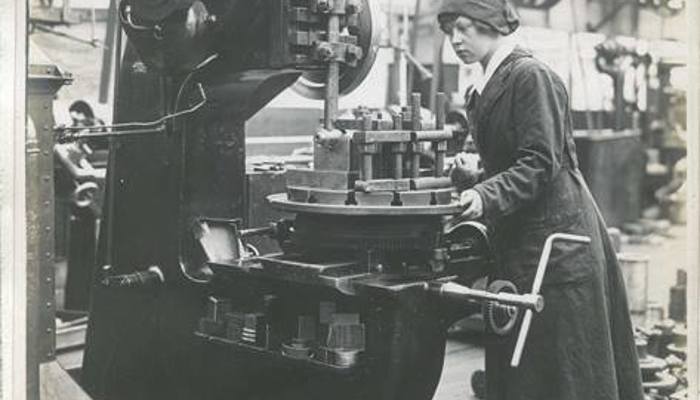
Ask the Archivist - Clyde-built ships
Clyde-built ships photos


Our next topic was a central part of Glasgow's history: shipbuilding! The Q&A is below. You can also read a feature about these records in the Glasgow Times.
Q1: Do the collections include personnel records?
This was a very popular question but sadly, despite the large collections, there are relatively few personnel records. The exceptions are:
Fairfields: apprenticeship certificates, 1913 - 1949 (giving brief indication of time-keeping and overall service record)
Barclay, Curle & Co Ltd: wages book, 1921 - 1924; salary lists dating 1905 - 1917;
Charles Connell & Co: paybooks. 1885 - 1966
John G Kincaid & Co Ltd: various office staff and foremen.
We also hold occasional photographs of staff, although usually only the department name is given such as the image of the apprentices from Fairfields. Please note that there will be restricted access to later staff records for data protection reasons.
Q2: How do I find ship plans and photographs at the City Archives?
The bulk of our shipbuilding archives are ship plans and photographs. Many of the plans are beautifully drawn. In our searchroom we have a Clyde-built card index (alphabetical by ship name), which we can search through for you. Each index card notes if we hold plans or photographs of that ship. We also have a copy of L.A. Ritchie’s ‘The Shipbuilding Industry’ which lists the details of many collections throughout the UK.
Alternatively, websites like the terrific Scottish Built Ships give details such as the shipbuilder and date of launch. Once the shipbuilder is known then it’s worth checking the online catalogue of the National Records of Scotland at to see where records are held.
Q3: What about John Brown and Co or Blythswood Shipbuilding Co Ltd?
Records for these companies are held by Glasgow University Archives Service – see their website for more details. However we sometimes have plans and/or photographs from private collections for these companies here too.
Q4: How is Elder Park associated with shipbuilding?
Glasgow born John Elder served his apprenticeship with local shipbuilder and engineer Robert Napier. In 1852 John Elder then became a partner in Randolph, Elder and Co and went on to produce a major innovation in marine engineering with the invention of the compound steam engine in 1854 that boosted the fuel efficiency of steam ships. The company began building ships in 1860, with a shipbuilding yard in Govan and later another at the site of the former Fairfield farm.
John’s wife Isabella was well-known for her charitable work within Govan, helping purchase and establish Elder Park, Elder Cottage Hospital and Elder Park Library. After her husband’s death in 1869, Isabella ran the company, now called John Elder & Co, for 14 months and the firm continued with other partners such as Fairfield Shipbuilding & Engineering Co.
Q5: Do the shipbuilding records give evidence about the working life in shipyards?
The biggest source for working conditions is probably the collection from the Clyde Shipbuilder’s Association which was formed in 1866. It was originally the Shipbuilding and Engineering Companies Association and had 24 subscribing firms. Its main function was to represent the employers in negotiations with trades unions, so it has a lot of details about disputes! As well as minutes and correspondence, the collection includes statistical info on wages, prices of piece work and labour, employment levels and regulations for the workforce.
Of course photographs, company magazines and the tenement architectural plans (where many workers lived) also give insight to worker’s lives.
Q6: What about women who worked in the industry?
It can be hard to find records about individuals, although there is fantastic set of photos of WW1 women workers (with names) from McKie & Baxter Ltd, marine engineers. The greater hiring of women to help with war effort was not entirely welcomed with some disputes over the ‘dilution’ of labour.
Q7: Do you have any favourite Clyde-built ships?
There’s so many to choose from! One that really captures the imagination is the Livadia. Built in 1880 by John Elder & Co’s Fairfield yard for Russian Tsar, Alexander II, with luxurious interiors and an unusual design (based on a turbot fish!) for extra stabilisation as the tsar was rumoured to suffer from sea sickness. Unfortunately, the tsar was assassinated in 1881 before he ever got to sail on it, although as the quirky design turned out to make the ship extremely unstable it’s probably just as well he never did...
